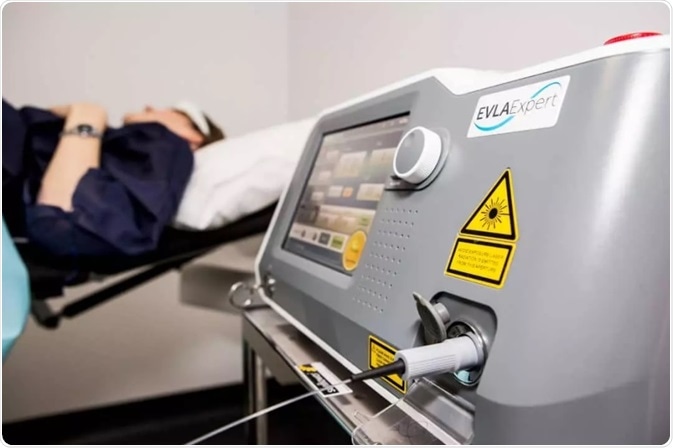Intravenous laser ablation (EVLA, sometimes referred to as EVLT) remains the gold standard treatment for varicose veins. It is also the recommended treatment for this condition according to the National Institute for Health and Care Excellence (NICE).
Image credit: Veincentre
EVLA treats the underlying condition that leads to varicose veins by restoring healthy blood flow to the legs. This technique effectively treats both the symptoms associated with varicose veins and their aesthetic appearance.
This simple in-and-out procedure is performed under local anesthesia on an outpatient basis, usually taking less than 1 or 2 hours, depending on the number of veins being treated.
The majority of patients undergoing this procedure have described the EVLA procedure and associated recovery period as uncomfortable but not painful.
Development and history of EVLA
EVLA was developed in the United States more than 20 years ago. Since then, the medical community has observed and published excellent long-term results regarding its safety and effectiveness.
The technique has revolutionized the treatment of varicose veins, meaning there is no realistic need to offer surgical stripping under general anesthesia as first line treatment for varicose veins.
The EVLA process
A laser fiber is inserted into the vein to destroy it. This is done by using ultrasound to guide the laser. Heat is applied and the laser fiber is moved slowly and carefully along the vein.
This process effectively kills the target vein, with the dead vein being slowly absorbed by the body. After this process is completed, a healthy blood flood is restored to the feet.
The EVLA process involves a number of key steps:
Pre-procedure
An ultrasound is performed before the EVLA procedure in order to identify the problematic, poorly functioning veins that are the underlying causes of the patient’s varicose veins.
Before the procedure begins, the patient is given comprehensive information about treatment options, including potential complications and success rates. This is usually done during the initial consultation.
It is important to weigh the benefits against the risks with any medical treatment and patients are advised to take them fully into account.
It is also vital that patients understand and are happy with the proposed treatment before they agree to proceed and sign the necessary documentation.
The procedure takes place in a small treatment room, with music of the patient’s choice played if it helps them feel more comfortable. The patient is also introduced to the nurse, who will be by her side throughout the procedure, helping to support her through the process.
The process
As an ultrasound scanner is used to guide the procedure, the specialist has a live view of the patient’s veins throughout.
A small bubble of local anesthetic is injected before a needle is inserted into the target vein containing the faulty valves. A thin guide wire is carefully inserted through the needle and into the vein.
Once this wire is in place, a sheath of thin plastic tubing is inserted over the wire and fed along the vein. The guide wire is then removed and the laser fiber is fed through the catheter into the vein.
With the laser fiber in place, a significant amount of local anesthetic is administered throughout the length of the vein using a series of injections along the leg. This extra local anesthetic will numb the leg and protect the tissues surrounding the target vein from damage.
With the leg fully anesthetized, the laser is activated, delivering powerful laser light directly into the vein and heating the tissues in the vein wall to a level capable of destroying them.
Once this is done, the laser fiber is slowly and gently withdrawn along the vein, heating the vein wall and destroying it in place as it passes through. The procedure takes 5 to 10 minutes per vein.
The local anesthetic ensures that patients do not experience any significant discomfort as the vein is lasered, although there may be some minor pain and patients may notice strange smells and tastes.
This process is repeated for each vein identified as causing the patient’s vein varicose veins.
A small number of patients—less than 5%—reported that local anesthetic injections and the laser were painful, although most find the sensations more odd and uncomfortable. However, there does not seem to be a clear pattern around which patients will find the experience painful.
After the vein is heated and destroyed, it may take several weeks for the body to naturally absorb the dead tissue left behind.
Once the vein is damaged, the blood that previously flowed through it is diverted into healthy, normal functioning veins. The impact of this diversion is minimal, as the damaged vein was not functioning properly to begin with.
After the procedure
After the procedure, a nurse will apply compression stockings to the treated leg, describing the application of the stocking and any post-treatment symptoms to be aware of. The patient is also asked to take a short 10-minute walk after the appointment.
Once this is done, the patient can go home. It is not possible to drive on the day of the treatment, but it is possible the next day. It is important to note that patients should not fly long distances (more than 4 hours) for a total of 4 weeks after the procedure.
Recovery
After the treatment, it is necessary to wear a compression stocking for a week. Patients may experience some narrowing as the vein shrinks over the next few weeks, and there will likely be bruising in the leg. This bruising is mild for most patients, but it can be quite severe. In both cases, this is a normal part of the healing process.
Most patients experience little or no pain and are able to resume their daily activities immediately, provided the support stocking is worn and these do not involve strenuous activities such as swimming, weight lifting, or horseback riding. It is important to follow the adviser’s advice in all cases.
A minority of patients will experience severe pain, often requiring time off work. If this happens, it is usually about 5-7 days after treatment and not immediately. This is when the treated veins begin to be absorbed by the body – a process that patients tend to describe as a tightening sensation.
Symptoms associated with varicose veins, such as pain, throbbing or itching, will begin to improve quickly after treatment with EVLA, with patients usually finding that their symptoms have completely resolved before their follow-up appointment.
EBLA monitoring
It is strongly recommended that patients attend a follow-up appointment approximately 6 to 8 weeks later EVLA treatment. Most patients will need some type of treatment at follow-up, but this appointment is mainly to verify that the EVLA treatment has successfully treated the underlying vein problems.
Varicose veins may still be present at follow-up, although they are generally much smaller. Varicose veins will rarely disappear completely after just one treatment and may still be of their original size.
However, this does not mean that the treatment has failed. EVLA corrects the underlying problem, but many patients require foam sclerotherapy or ablation/phlebectomy in order to treat true varicose veins.
About Veincentre


At Veincentre, we provide the most effective, proven treatment and the highest quality care accessible to all. We treat the cause, not just the symptoms! All of our treatments are minimally invasive – extubation, withdrawal, no general anesthesia required, no surgery and no time off work.
The most important aspect of care for any condition is the skill and attitude of the team of doctors and nurses who care for you. We’ve hunted down some of the most experienced and respected vein specialists in the UK. By choosing Veincentre, you can be sure that discomfort will be minimized, results will be optimized and you will be looked after by a team that really cares about you
From your initial point of contact you will be in contact with our patient advisors, who only deal with patients suffering from varicose veins, so they are all very experienced and can confidently answer all your queries or provide any advice.
Start your journey to healthy veins and happy feet…
Sponsored Content Policy: News-Medical.net publishes articles and related content that may come from sources where we have existing commercial relationships, provided that such content adds value to News-Medical.Net’s core editorial ethos of educating and informing website visitors interested in medical research, science, medical devices and treatments.


